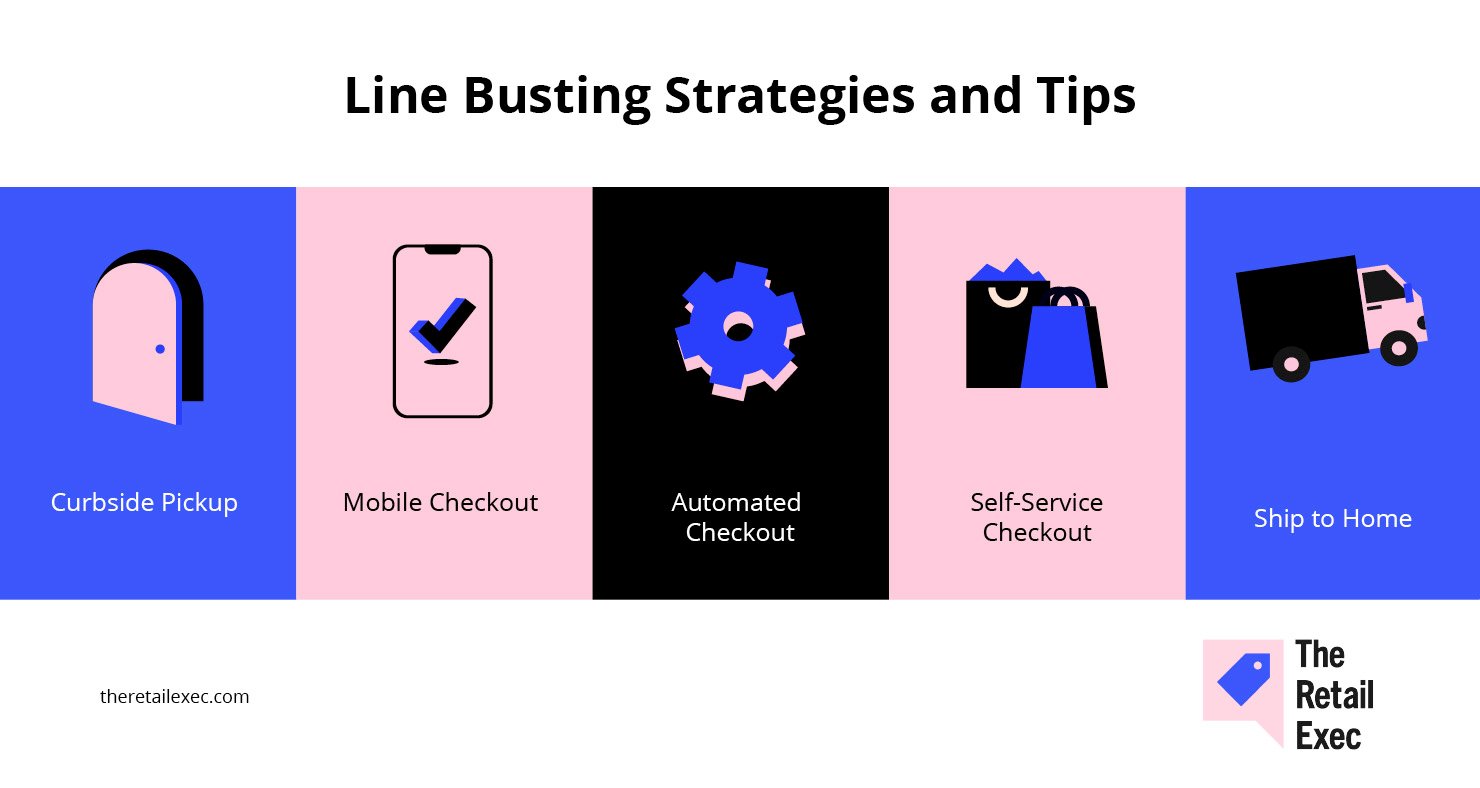Customers hate waiting in line. 70% of consumers said they’re willing to wait a maximum of 15 minutes in a physical line for an item or service.
While that’s a reliable number, it’s safe to assume that customers are likely to leave long before 15 minutes.
But even while customers wait, they’re silently resenting.
MIT Professor Dick Larson (aka Dr. Queue) has spent the past 30 years studying the psychology of waiting in line. He coined the term “queue rage,” which represents the anger, resentment, and frustration customers feel when they’re standing in line while someone who arrived after them gets served prior.
Cutting these lines short can be instrumental in improving the customer experience at your store and boosting your topline. But how exactly do you do it?
My combined experience as an accountant and writer for B2B brands equips me with a unique perspective to address this challenge. I understand the importance of streamlining operations to maximize efficiency and how technology can enhance customer satisfaction.
In this guide, we help you understand the meaning of line busting and ways to break lines at your store.
By integrating practical insights and actionable strategies, I aim to help you implement effective line-busting techniques that not only improve the customer experience but also drive measurable growth for your business.
Let’s dive in!
What is Line Busting?
Line busting refers to the use of technology to help customers move through lines quickly at checkout.
If you’ve ever seen footage of angry customers waiting in line, you know it can get ugly pretty quickly. Line busting aims to prevent this from happening at your business.
The idea is to “bust” or break up lines by streamlining checkout using mobile point-of-sale (mPOS) systems (one of the many types of POS systems), self-service kiosks, or by offering a buy online pick-up in-store (BOPIS) facility.
With these strategies, you can ultimately improve your in-store experience and lower the pressure on the staff handling checkout counters. It’s a must to become a truly omnichannel brand.Successful line busting also helps protect your topline—over 17% of customers say they’ll walk away from a company after one bad experience, with this number increasing to 50% after multiple poor experiences.
Top Benefits of Line Busting
So, now that we know the importance of line busting on your business, let’s look at some benefits so you can get a sense of what to expect.
Faster checkout
According to a recent Yahoo! Finance survey, the average consumer spends 3,700 hours a year waiting in line. Whoa.
Customers are more likely to walk away from a purchase if wait times feel excessive—especially for low-priority or impulse items.
Line busting helps get these customers through checkout by speeding up the checkout process. And this is great news for your business—faster checkout times and higher customer throughput can greatly increase your profitability.
Reduced store congestion
Congested stores are what mosquito repellents are to mosquitoes. Customers who see a long line at your store might avoid stopping by altogether.
Preventing long queues with line busting strategies can help accommodate more customers.
If you’ve been in retail for a while, you probably understand how important that first step is—customers can buy items only once they walk in, right?
Reduced store congestion champions this ideology, and also helps your business get potential new clientele who might otherwise not visit.
Improved customer service
Customer rage is getting worse with social media shortening our attention spans and the recent pandemic adding fuel to the fire.
Angry customers are bad for business, not only because they tell other people about their poor experience, but also because they cause frustration among frontline staff and can trigger them to quit.
Providing great customer service isn’t just about keeping customers happy, but also keeping employees happy—after all, who do you think handles your customer experience?
Research shows that rudeness is like the common cold: It’s contagious, it spreads quickly, anyone can be a carrier—at work, at home, online, or in our communities—and getting infected doesn’t take much.
Overall, line busting negates this and keeps the ill effects of crowded checkout counters away. It helps you improve customer satisfaction and minimize rude interactions between your staff and angry customers.
How to Start Line Busting the Right Way

If you’re ready to start implementing one of these line busting tactics, you’ll need to lay some groundwork depending on your chosen strategy.
Let’s talk about some things you might need to start busting lines at your store.
1. Choose the right mobile POS
As we established, you need an mPOS system for mobile payments. You also need a smartphone or tablet that you can install the mPOS on.
There’s no shortage of options out there—each with different features, integrations, and pricing.
If you’re unsure where to start, check out our guides on POS system costs and the best mobile POS systems on the market.
2. Invest in the right tech stack
The hardware and software you need will vary depending on which line busting strategies you’re using:
- mPOS systems require mobile devices and contactless card readers
- Self-service checkouts may need barcode scanners or kiosks
- Curbside pickup can often be supported by a lightweight ecommerce integration
If you’re implementing more than one solution, make sure your tools can integrate with your existing POS, inventory, and customer data systems to avoid fragmentation.
3. Rethink your staffing model
Line busting doesn’t eliminate the need for staff—it redistributes it.
Self-checkout may reduce staffing at the counter but increases the need for floor staff who can assist with technical troubleshooting—glitches or inexperience on the part of the customer.
Mobile checkout requires more active employee engagement throughout the store. When rethinking your staffing, consider not just headcount, but how roles will shift and what kind of real-time support customers might need.
4. Train (and retrain) your employees
Every line busting strategy involves new tech—so your team needs to know how to use it confidently. Train them to operate devices, follow secure payment protocols, and assist customers who may struggle with new checkout flows.
Ongoing training is key, not just a one-and-done onboarding.
As systems evolve, make sure your employees are learning with them. The better trained your staff, the faster and smoother your checkout experience will be.
Line Busting Strategies and Tips
Now that you understand what line busting is and why it matters, let’s look at a few effective strategies you can implement today.

Curbside pickup (a.k.a. click-and-collect or BOPIS)
Curbside pickup blends online convenience with offline efficiency. Customers place orders online, then pick them up at your location—usually by showing an ID or order confirmation.
This strategy eliminates wait times, reduces in-store congestion, and removes the cost and logistics of shipping. It's a win-win for both retailers and customers.
As a bonus, it’s built on systems you may already have in place: ecommerce ordering, local inventory visibility, and mobile notifications.
Mobile checkout (mPOS systems)
Mobile checkout allows staff to detach from the cash counter.
mPOS terminals are smartphones and tablets, which means every staff member turns into a walking checkout counter.
Instead of getting in line to pay, customers can simply approach an employee to complete their payment and exit the store with their items.
This works especially well in busy retail environments—like apparel or electronics—where shoppers want fast service without long waits.
In the restaurant world, it’s already common: staff bring a tablet to the table to take payments on the spot, eliminating the back-and-forth with checks.
Bonus: Mobile checkout frees up your team to focus more on upselling, answering questions, and improving the in-store experience.
Automated checkout (think: Amazon Go)
Automated checkout—like Amazon’s “Just Walk Out” technology—is the most futuristic (and most expensive) line busting strategy.
Customers scan an app on entry, grab what they need, and leave. Sensors and cameras track purchases and bill them automatically.
While automated checkouts seem too expensive, various startups are working on making this technology more affordable.
We’re still a bit far away from a time when automated checkouts are democratized, but Standard Cognition is one of the front-runners in the race to make this happen.
Self-service checkout
Over 53% of people now prefer using digital wallets—making self-checkout more viable than ever.
The preference for digital payments enables a key line busting strategy that’s already widely in use: self-service checkout (or self-checkout).
Think about it: Retail stores have sensors to detect items that haven’t been paid for at exit doors, and there are now barcode scanners at the checkout counter. The employees are essentially just present to collect cash.
Retailers like Walmart use this approach at scale, offering scan-and-go options where customers scan items with their phones and pay digitally while they’re shopping.
Self-service kiosks are also common in fast casual restaurants like McDonald’s, where customers can order and pay without interacting with staff.
While this approach can reduce staffing at checkout, you’ll still need floor employees to assist with questions, overrides, or tech hiccups. Theft prevention and user experience remain critical considerations.
Ship to home from store
Ship to home is a strategy where customers use their own devices to check out instead of an employee’s.
This line busting strategy comes in handy when customers find items they like at your store but want a different color, style, or size that’s currently unavailable at your location.
The customer can place an order at the store, complete the payment using their device, and request the item be shipped to their home once it’s back in stock.
Potential Pitfalls of Line Busting
While there are quite a few benefits of line busting, implementation comes with a few challenges.
They’re not unsolvable, but being mindful of them and planning for them before you start implementing a line busting strategy is mission-critical.
Technical challenges
Line busting depends heavily on tech—mPOS systems, kiosks, mobile apps—which means you’re introducing new potential failure points.
Glitches at checkout, spotty Wi-Fi, or integration issues with legacy systems can frustrate customers more than waiting in line.
To help streamline your line busting processes, consider partnering with vendors that offer quick support and training internal staff to fix problems. No matter how well you plan, you will run into these types of problems from time to time.
Undertrained (or overwhelmed) staff
No matter how sleek your new checkout tools are, they’re only as effective as the people using them. If employees don’t fully understand how to use the systems—or how to help customers troubleshoot on the spot—lines may grow even longer.
Zero points for guessing—it doesn’t matter to customers that the employee is just a junior trying to figure out how things work.
Worse, team members may resist the change altogether. Tech anxiety or lack of clarity around new roles can lead to disengagement.
Invest in proper training, and go beyond one-time onboarding. Build in refreshers, create quick reference tools, and communicate how these changes benefit staff—not just customers.
Data security risks
The bottom line: all POS systems are vulnerable to a range of attacks, such as memory scrapers, keyloggers, network sniffers, and file injectors.
To mitigate this, follow retail cybersecurity best practices:
- Keep all systems updated
- Enforce strong passwords and access controls
- Secure physical devices on the sales floor
- Train staff on phishing, fraud detection, and device safety
And don’t forget perception: customers want to feel that their payment data is safe. The more visible and seamless your security protocols are, the more trust you’ll earn at checkout.
Lines Are Optional Now—Rethink Your Checkout Strategy
Long lines aren’t just annoying—they’re expensive. Customers don’t wait around, and neither should you.
From mobile checkout to self-service kiosks to curbside pickup, line busting gives you a toolkit to reclaim the in-store experience and convert more foot traffic into revenue. But like any operational change, success comes down to the right mix of tech, training, and team buy-in.
Start small, test often, and measure impact.
Whether you’re managing a handful of locations or rolling out changes across hundreds of stores, a smart line busting strategy can become a competitive advantage—not just a customer convenience.
Retail never stands still—and neither should you. Subscribe to our newsletter for the latest insights, strategies, and career resources from top retail leaders shaping the industry.


